Bradley, David Eldred (Flying Officer)
Killed in Flying Accident 1956-August-20
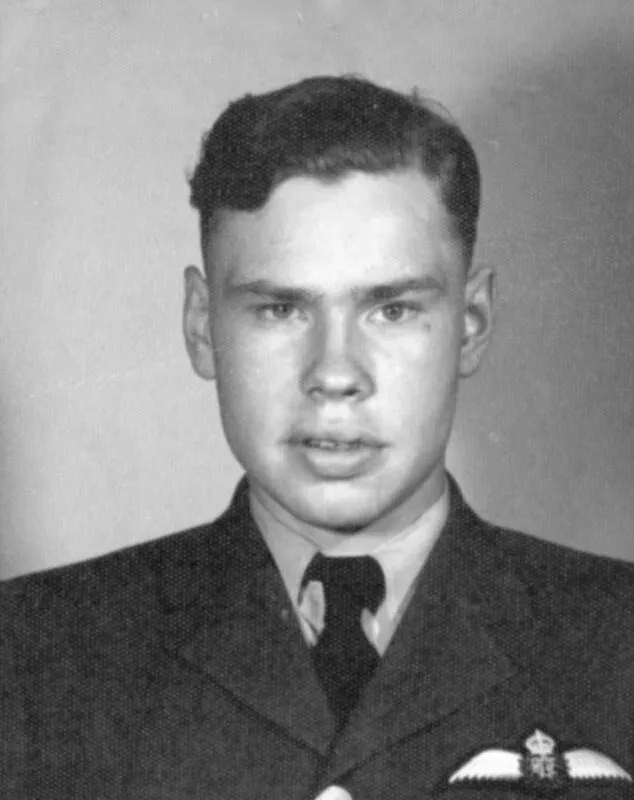

Birth Date: 1933-October-16
Born: Newdale, Manitoba
Parents: Son of Carl and Alexandra Bradley of Newdale, Manitoba. Brother of Lorne and Sabra.
Spouse:
Home: Newdale, Manitoba
Enlistment: Brandon, Manitoba
Enlistment Date: 1951-October-16
Service
RCAF
Unit
441 Sqn- Squadron
Stalk and Kill
Base
Rank
Flying Officer
Position
Pilot
Service Numbers
Home
Sabre serial: 23654
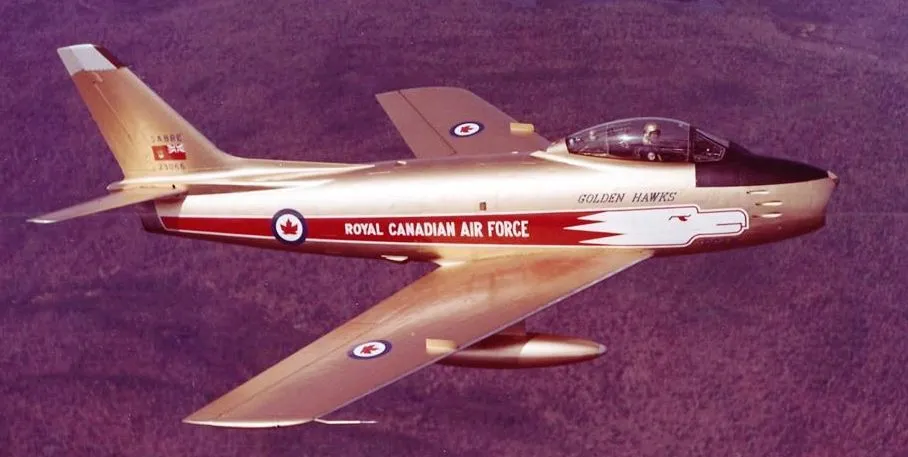
Canadair CL-13 Sabre Mk. 5 (Serial No. 23066), Golden Hawks
The North American F-86 Sabre, sometimes called the Sabrejet, is a transonic jet fighter aircraft. Produced by North American Aviation, the Sabre is best known as the United States' first swept-wing fighter that could counter the swept-wing Soviet MiG-15 in high-speed dogfights in the skies of the Korean War (1950"“1953), fighting some of the earliest jet-to-jet battles in history. Considered one of the best and most important fighter aircraft in that war, the F-86 is also rated highly in comparison with fighters of other eras. Although it was developed in the late 1940s and was outdated by the end of the 1950s, the Sabre proved versatile and adaptable and continued as a front-line fighter in numerous air forces.
Its success led to an extended production run of more than 7,800 aircraft between 1949 and 1956, in the United States, Japan, and Italy. In addition, 738 carrier-modified versions were purchased by the US Navy as FJ-2s and -3s. Variants were built in Canada and Australia. The Canadair Sabre added another 1,815 aircraft and the significantly redesigned CAC Sabre (sometimes known as the Avon Sabre or CAC CA-27), had a production run of 112. The Sabre is by far the most-produced Western jet fighter, with a total production of all variants at 9,860 units.
The fighter-bomber version (F-86H) could carry up to 2,000 lb (907 kg) of bombs, including an external fuel-type tank that could carry napalm. Unguided 2.75-inch (70-millimeter) rockets were used on some fighters on training missions, but 5-inch (127 mm) rockets were later carried on combat operations. The F-86 could also be fitted with a pair of external jettisonable jet fuel tanks (four on the F-86F beginning in 1953) that extended the range of the aircraft. Both the interceptor and fighter-bomber versions carried six 0.50 in (12.7 mm) M3 Browning machine guns with electrically-boosted feed in the nose (later versions of the F-86H carried four 20 mm (0.79 in) cannon instead of machine guns). Firing at a rate of 1,200 rounds per minute, the 0.50-inch guns were harmonized to converge at 1,000 ft (300 m) in front of the aircraft, using armor-piercing (AP) and armor-piercing incendiary (API) rounds, with one armor-piercing incendiary tracer (APIT) for every five AP or API rounds. The API rounds used during the Korean War contained magnesium, which were designed to ignite upon impact, but burned poorly above 35,000 ft (11,000 m) as oxygen levels were insufficient to sustain combustion at that height. Initial planes were fitted with the Mark 18 manual-ranging computing gun sight. The last 24 F-86A-5-Nas and F-86Es were equipped with the A-1CM gunsight-AN/APG-30 radar, which used radar to automatically compute a target's range, which later proved to be advantageous against MiG opponents over Korea. Wikipedia
![]() Wikipedia North American F-86 Sabre
Wikipedia North American F-86 Sabre
![]() YouTube F-86 Sabre Aerobatics - No Music! - Airshow London 2018
YouTube F-86 Sabre Aerobatics - No Music! - Airshow London 2018
F-86 (Canadair Sabre) Part Manual Volume I
F-86 (Canadair Sabre) Part Manual Volume II
F-86 (Canadair Sabre) Maintenance and Diagrams (Partial Document)
Unit Desciption
441 Sqn Stalk and Kill ("Silver Fox")
History of the Squadron before and during World War II (Aircraft: Spitfires of several Mks, Mustang III)
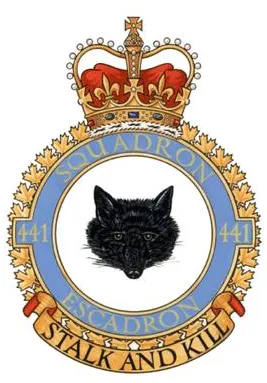
No 441 (F) Squadron was formed in Sydney, NS ![]() as No. 125 (F) Squadron RCAF on 20 April 1942. It flew Hawker Hurricane aircraft on East Coast air defence. It was the fourth of six home squadrons transferred overseas without its aircraft, and was re-designated No. 441 (F) Squadron RCAF at Digby, Lincolnshire, UK
as No. 125 (F) Squadron RCAF on 20 April 1942. It flew Hawker Hurricane aircraft on East Coast air defence. It was the fourth of six home squadrons transferred overseas without its aircraft, and was re-designated No. 441 (F) Squadron RCAF at Digby, Lincolnshire, UK ![]() on February 8 1944. It flew Spitfire aircraft in offensive and defensive operations in the preparation for D-Day, and afterwards gave close support to the ground troops. It moved with the ground troops through France and Belgium, and returned to the UK in October 1944 and flew from various bases there until the end of hostilities in Europe. In May 1945 the squadron was re-equipped with Mustang aircraft, to provide fighter cover for long-range bomber groups, but were never operational in this role. The squadron was disbanded at Molesworth, Huntingdonshire, UK
on February 8 1944. It flew Spitfire aircraft in offensive and defensive operations in the preparation for D-Day, and afterwards gave close support to the ground troops. It moved with the ground troops through France and Belgium, and returned to the UK in October 1944 and flew from various bases there until the end of hostilities in Europe. In May 1945 the squadron was re-equipped with Mustang aircraft, to provide fighter cover for long-range bomber groups, but were never operational in this role. The squadron was disbanded at Molesworth, Huntingdonshire, UK ![]() on August 7, 1945.
on August 7, 1945.
In the course of operations, the squadron flew 3148 sorties for the loss of16 pilots, of whom 2 were killed, 7 presumed dead and 6 POWs. They accounted for 56 enemy aircraft confirmed destroyed and 12 damaged. In ground attacks they were credited with 500-plus vehicles. The squadron had 3 aces: Flight Lieutenant D.H. Kimball, DFC; Flight Lieutenant G.E. Mott, DFC and Flight Lieutenant T.A. Brannigan DFC. The squadron amassed 9 DFCs, 1 Croix de Guerre (France) and 3 MiDs. Battle Honours were: Defence of Britain 1945, Fortress Europe 1944, France and Germany 1944-45, Normandy 1944, Arnhem, Walcheren.Wikipedia, Kostenuk and Griffin
Maps for Movements of 441 Squadron 1944-45
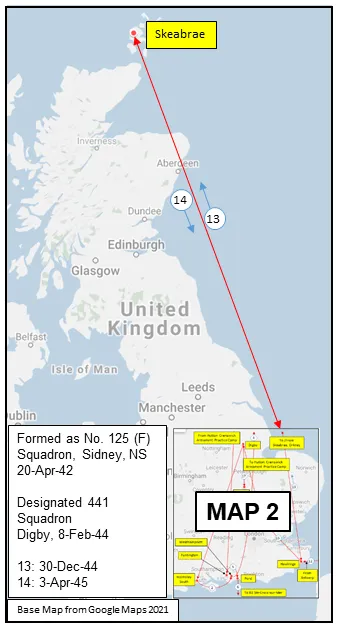
MAP 1: 441 Squadron Movements 1944-45 (right-click on image to display enlarged in new tab)
|
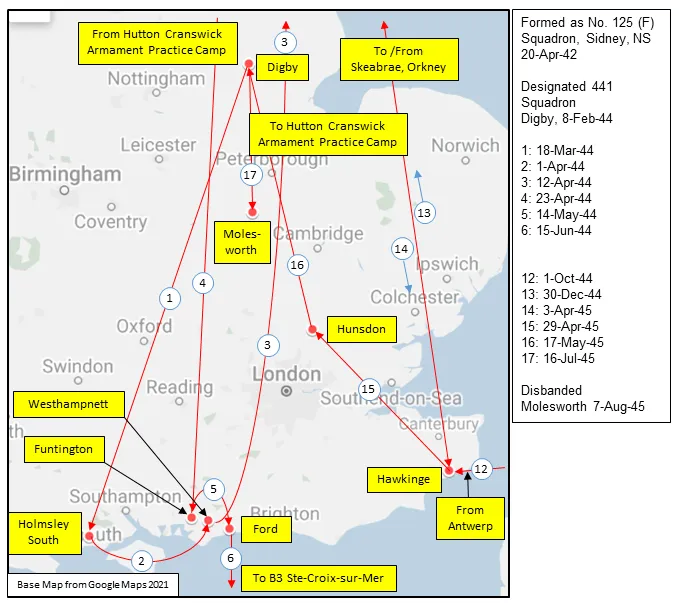
MAP 2: 441 Squadron Movements 1944-45 (Detail of Map 1)
|
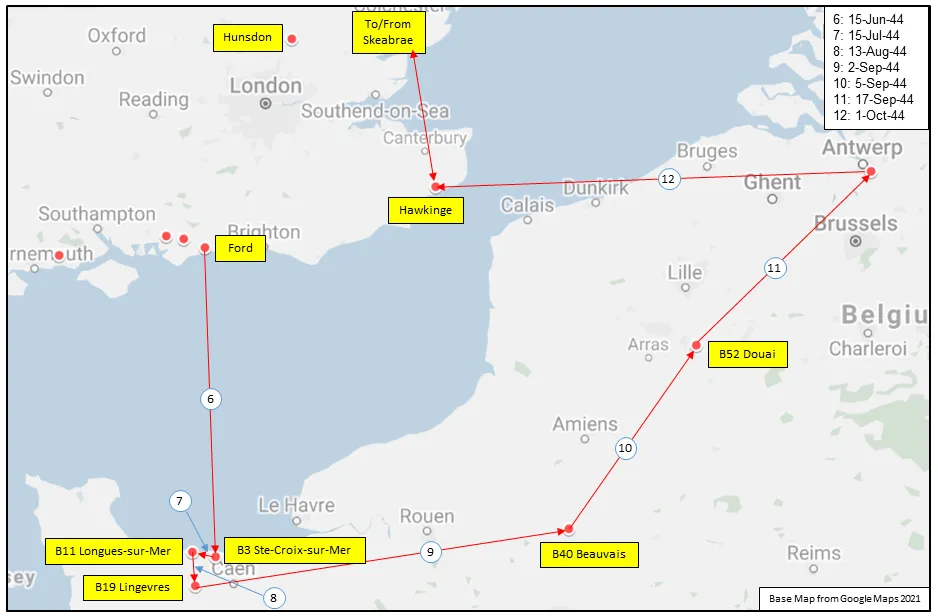
441 Squadron History Summary 1944-45
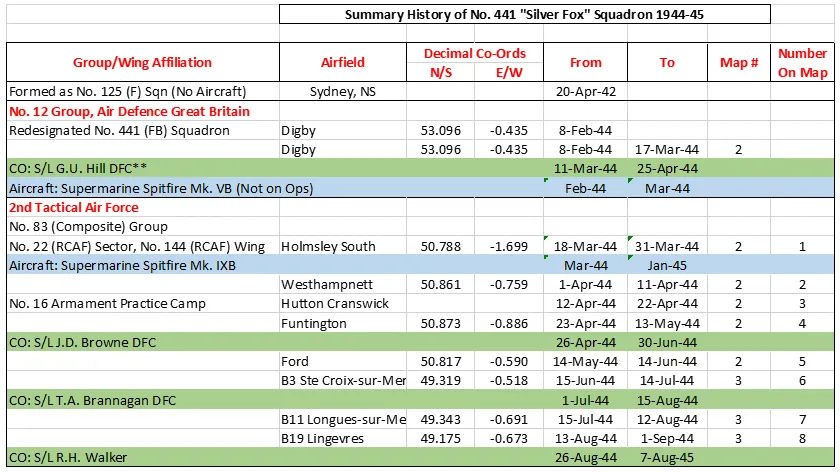
441 Squadron History Summary 1944-45 Page 2
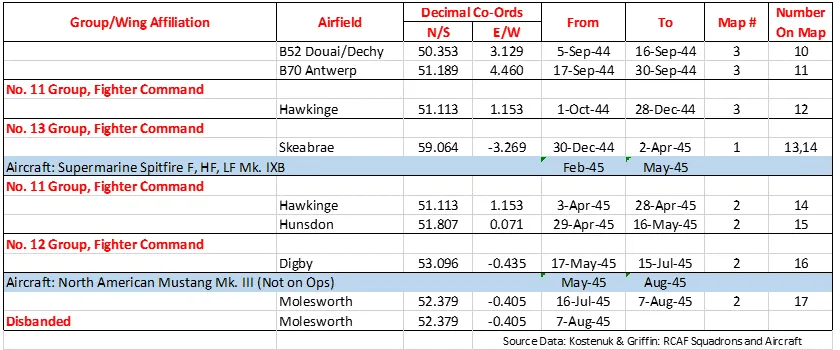
History of the Squadron Post-WWII (Aircraft: Vampire III, Sabre 2, 5, 6, Starfighter, Hornet)
No 441 Squadron reformed at RCAF Station St. Hubert ![]() on 1 March 1951, flying de Havilland Vampire III and later Canadair Sabre Mks. 2, 5 and 6. They joined No 1 (Fighter) Wing, then located at RAF North Luffenham, in Rutland, England
on 1 March 1951, flying de Havilland Vampire III and later Canadair Sabre Mks. 2, 5 and 6. They joined No 1 (Fighter) Wing, then located at RAF North Luffenham, in Rutland, England ![]() on 13 February 1952. The squadron was temporarily situated at 3 Wing Zweibrücken, Germany
on 13 February 1952. The squadron was temporarily situated at 3 Wing Zweibrücken, Germany ![]() on 21 December 1954, before moving to their intended destination, RCAF Station Marville, France
on 21 December 1954, before moving to their intended destination, RCAF Station Marville, France ![]() . It was selected as one of the eight squadrons to be re-equipped with the CF-104 Starfighter, so it was deactivated on 1 September 1963 at Marville and then reactivated (reformed) as No 441 Strike/Attack squadron on 15 September. It then moved with 1 Wing to CFB Lahr, Germany
. It was selected as one of the eight squadrons to be re-equipped with the CF-104 Starfighter, so it was deactivated on 1 September 1963 at Marville and then reactivated (reformed) as No 441 Strike/Attack squadron on 15 September. It then moved with 1 Wing to CFB Lahr, Germany ![]() in April 1967. On 1 February 1968 the squadron was integrated into the Canadian Armed Forces. In 1971 the squadron moved to CFB Baden-Soellingen
in April 1967. On 1 February 1968 the squadron was integrated into the Canadian Armed Forces. In 1971 the squadron moved to CFB Baden-Soellingen ![]() and changed its name to 441 Tactical Fighter Squadron. They disbanded again in 1986 and then finally reformed at 4 Wing Cold Lake, Alberta
and changed its name to 441 Tactical Fighter Squadron. They disbanded again in 1986 and then finally reformed at 4 Wing Cold Lake, Alberta ![]() on 26 June 1986, flying CF-18 Hornet aircraft. The squadron flew mostly close air support and battlefield air interdiction missions over Kosovo and the Federal Republic of Yugoslavia, under Task Force Aviano, 5 Allied Tactical Air Force from 12 April to 10 June 1999.
on 26 June 1986, flying CF-18 Hornet aircraft. The squadron flew mostly close air support and battlefield air interdiction missions over Kosovo and the Federal Republic of Yugoslavia, under Task Force Aviano, 5 Allied Tactical Air Force from 12 April to 10 June 1999.
On 6 July 2006, No 441 Squadron was finally stood down (disbanded), and its crews amalgamated with 416 Tactical Fighter Squadron at CFB Cold Lake and re-formed as 409 Tactical Fighter Squadron. The squadron's colours and battle honours have been placed in Sydney, Nova Scotia, where it first operated.